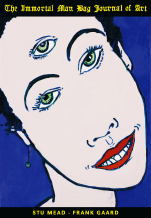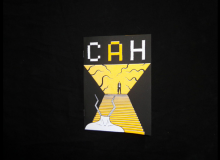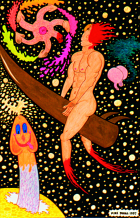| Umělec 2007/4 >> YOUNG MAN WITH A MINOLTA AROUND HIS NECK | Просмотр всех номеров | ||||||||||||
|
|||||||||||||
YOUNG MAN WITH A MINOLTA AROUND HIS NECKUmělec 2007/401.04.2007 Lenka Vítková | silverprint | en cs de es |
|||||||||||||
|
Photographs from the 1970s in ČSR (Czechoslovak Republic), Gallery U Bílého jednorožce, Klatovy, curators Jan Freiberg and Pavel Vančát, September 2 – October 28, 2007.
Czechoslovaks expected normalization to set in after the withdrawal of Soviet troops from our land. In Gustáv Husák’s opinion, however, the so-called “normalization conditions” had to be imposed with the occupants still in the country. In this context, normalization may also be interpreted as the acceptance of the reality and the restrictions on life in a Soviet satellite, where the “thereafter” was no longer anticipated, and life was instead lived in the now. An anonymous voice from Vladimír Páral’s opus Joy until Morning speaks from normalization’s deepest days about what his heroes have in common: “They rebel together against that which is passed off as the norm, the status quo. In fact, they fight against those who have managed to acquiesce—without any sense of inferiority or guilt—to their everydayness, for whom that was no major feat; they fight against those who “normally,” duti- fully obey their obligation to work hard, yet just as automatically enjoy all the advantages their work brings them.” In the 1960s, Vladimír Páral, himself a chemical engineer, established his narrative settings in the factories of northern Bohemia; in the 70s, with the novels Professional Woman, Young Man and White Whale, Joy until Morning, and General Miracle he, in an effort to smooth over the critical tone of his previous works yet maintain a sense of detachment, shifted to literature parodying pulp fiction, corresponding with the era’s retro-fashion (manifested in graphic design by accenting the appeal of bourgeois aesthetics); in the 80s, he managed a literary escape from stagnant normalization-era settings to the distant future of sci-fi. Photographers and writers were in a similar position in the 80s. They felt themselves to be members of an elite group for which society had no place, but which they, in society’s eyes, nevertheless represented. The romantic aura enveloping the photographic figure was summed up in the 80s by the film Good Light (1986, dir. Karel Kachyňa), where Karel Heřmánek as photographer Viktor Průcha finds his muse in the Roma girl Aranka, whose risqué photographs cause a scandal and create problems for him in his socialist collective. Those troubles, however, only amplify the photographer’s sex appeal, an important element of which is the freedom to manifest his own view of the world. Otherwise, there are known cases of photographers who were led to their craft by Antonioni’s Blowup. As the goal of curators Pavel Vančát and Jan Freiberg was to reconstruct the period’s visual likeness via photography, they neither concentrated exclusively on the work of the eminent personages through whom art history is commonly presented, nor limited the content of the exhibition exclusively to “artistic” photography. Having included advertising photography and amateur works as well, they even embraced a few works bordering on kitsch. On one hand, the exhibition “Photography of the 70s in the Republic of Czechoslovakia,” which was presented in a three-storey gallery in the western Bohemian town of Klatovy, conveys what was in front of the lens, and on the other it simulates the social context behind the camera or around the photographer. Roughly 80 percent of the work chosen by Vančát and Freiberg came from the personal archives of photographers. Thanks to that, they amassed a medley of works that goes far beyond those that were lauded in their day and thus found their way the collections of state institutions. This contemporary selection led them to a much more vivid image of 70s photography than they would have arrived at had they simply chosen what had already been classified and verified by history. In so doing, during research trips the curators obtained a fine overview of the later lives of their protagonists. The curators’ hunter-collector-archivist approach was reflected in the character of the installation, too. The unusual arrangement of photographs—displayed in clusters, grids, and on panels—evoked the feeling that even the “in-between” was exhibited. Sometimes more means more. Each photo would naturally stand out better in a more minimalist installation; nevertheless, the quantity here is a manifestation of interest, not arrogance. On display here was not only the material itself but also the breadth of the selection— as if the curators had pitted their own obsession with showing against the photographers’ obsession with capturing. We are, after all, returning to the period when the modifier “mass” was routinely used. By partitioning the halls with panels, as was the installation norm in the 70s, they suggested the paths, and the dead-end streets, which photography followed thereafter. With regard to categorization, the installation contained a number of the curators’ personal references— although not necessarily obvious, they nevertheless provided a valuable clue to the curators’ approach, their persistent pursuit of the era’s meaning and visageas a consequence of societal conditions. The cloth-covered panels, glass frames, and the environment of the gallery itself—which, by the way, has seen its day—respected the manner in which such photography had been installed in the era it was made, when a clear dividing line between craft, kitsch, and art in photography had yet to be drawn. Under conditions of limited freedom, in which taking out a marriage loan was the pinnacle of self-fulfillment, all leisure-time activities and hobbies—besides tramping, cottage-tending, gardening, and photography— thrived. In the 70s there was a dense network of photography clubs, panelák bathrooms en masse transformed into darkrooms fitted with red light bulbs. On the first floor of the gallery, the work of the photography groups Setkání (meeting) and Epos represented the vast amateur photography hotbed of the 70s. In arranged theatrical photography, the white torso of a woman’s body shines from an inhospitable post-industrial landscape in a genre which could almost be labeled “folk surrealism.” The photo contest trophies suggest that, for such groups, photography was a colorful addition to their lives, wavering somewhere between sport and art, spiked with a dash of adrenalin when participating in domestic and foreign competitions at home and abroad. The large volume of exhibited documentary works reminds us that documentary photography established itself in the 70s as a separate and very viable genre. It was an era in which numerous documentary photographers discovered the themes which they have stuck with until today, and in which many experienced the height of their careers. Photography crystallized sociologically, series capturing true images of big city life were born. Another predominant motif of documentary shots is the quest for the “idyll” or, alternatively, for the opposite of the banal status quo – it happened in Roma settlements, in the environs of the Slovak mountains, sometimes in foreign countries with hard currencies—photographers balancing on the verge of triviality in scenes of company parties, shots of children, in portrayals of the village as the mirror image of the whole world, as well as a place of timelessness and resignation to fate. The section devoted to decorative photography worked within the exhibition as an accurate window display for all things 70s. Calendars or album covers represent the period’s aesthetical ideals and idols. Photography started to be applied in interior design, and some special techniques—such as photographic image transfer to laminate boards, which gave way to smoke- and humidity- resistant pictures—were developed. Advertisement photography for socialist enterprises’ products was, on one hand, a tool for feigning that the quality is truly the result of free and healthy competition, and, on the other, an export commodity (the difference between production for export and the domestic market is well evident) and a prestigious occupation. A professional photographer was an elite figure back then. The exposition on the second floor of the gallery, built around the personage of Jan Svoboda, indicated artistic photography’s acceleration toward abstraction and its transformation to wall art. In 1975, the Department of Artistic Photography was established at the Film and TV School of the Academy of Performing Arts (FAMU), where, until then, the vast majority of photographers had sought to hone their skills within the cinematography department. FAMU graduates’ automatic membership in the Czech Visual Artists Fund generated a whole new set of professionals. The era of amateurs had ended. The conceptual photography exhibited on the stairway leading to the top floor of the building, thus the end of the gallery space, suggested that behind that reality lies another reality, one which could become the subject of a personal probe, conducted even by non-photographers and beyond the limitations of a single medium.
01.04.2007
Рекомендуемые статьи
|
|||||||||||||
|
04.02.2020 10:17
Letošní 50. ročník Art Basel přilákal celkem 93 000 návštěvníků a sběratelů z 80 zemí světa. 290 prémiových galerií představilo umělecká díla od počátku 20. století až po současnost. Hlavní sektor přehlídky, tradičně v prvním patře výstavního prostoru, představil 232 předních galerií z celého světa nabízející umění nejvyšší kvality. Veletrh ukázal vzestupný trend prodeje prostřednictvím galerií jak soukromým sbírkám, tak i institucím. Kromě hlavního veletrhu stály za návštěvu i ty přidružené: Volta, Liste a Photo Basel, k tomu doprovodné programy a výstavy v místních institucích, které kvalitou daleko přesahují hranice města tj. Kunsthalle Basel, Kunstmuseum, Tinguely muzeum nebo Fondation Beyeler.
|








































 New book by I.M.Jirous in English at our online bookshop.
New book by I.M.Jirous in English at our online bookshop.
Комментарии
Статья не была прокомментированаДобавить новый комментарий